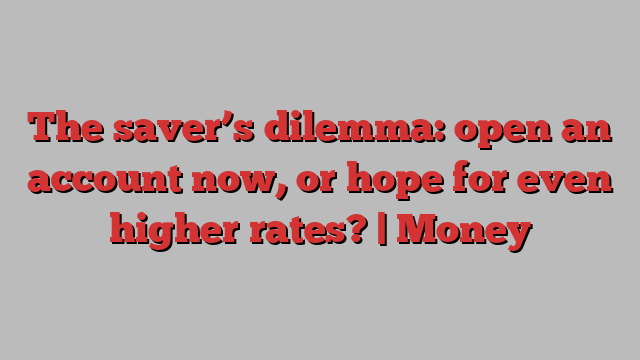
Rising interest rates mean savers are being offered the best returns in years, with some of the latest deals at more than 6%. After a flurry of activity last week, Anna Bowes, co-founder of website Savings Champion, says fixed-rate deals are more competitive than ever before.
“There’s a group of providers that keep leapfrogging each other in the best-buy tables – it’s only by small amounts, but it’s pushing up rates every time,” she says. “One account that launched and looked great was pushed out of the top five an hour later.”
But for those with money to put away, there are things to consider.
At a time of rising rates, is it wise to lock into a fixed-rate account? And are these deals really that good when inflation is taken into account?
Fixed rates
The best-buy savings accounts are currently those that involve locking in, and are typically being offered by small challenger banks, rather than high-street names.
Usually, the longer the period over which you are willing to commit, the better the returns, but the difference is currently negligible. According to Savings Champion, on Friday the best-buy one-year rate was 6% from Charter Savings Bank. Its two-year rate comes in at 6.1%. Both have high minimum deposits – you will need at least £5,000 to put away.
You can, however, earn almost as much with a much smaller sum – Tandem Bank was offering 5.85% on balances of just £1.
As things are moving so quickly there’s a risk that, by taking a fixed-term deal, you could miss out on a higher rate in the next week.
Earlier this year, accounts offering 4% for three years looked reasonable – now, you might be annoyed you didn’t wait.
One solution is to open a series of accounts, rather than putting all of your money in one, subject to the minimum deposit size. Instead of putting, say, £3,000 into one account now, you could allocate £1,000 this week and hold on to see what comes along next week.
This could be a hassle, but there are third-party services, such as Raisin UK, that let you pay everything in at once and then spread money between providers.
Bowes says this can save legwork but cautions it doesn’t cover the whole market. Currently, Raisin’s best one-year fixed-rate pays 5.72%. “If you want to squeeze everything you can out of your savings, you’ll need to go direct,” she says.
Another route to spreading the risk of missing out is to put some money in a one-year account, some in a three-year and some in a five-year. “Next year, if rates have gone up, you can move the one-year money into that [higher interest account]. If rates have fallen, you’ve still got the three- and five-year accounts,” Bowes says.
Unfortunately, no one can tell you when interest rates will peak and at what level, so there will be a bit of a gamble involved in any fixed-rate account. Typically, you will not be able to withdraw your money until the end of the term, so you need to be sure that you don’t need it.
Bowes says that, instead of kicking yourself, remember that you’re getting a better rate than many recent savers. “Someone who took out a one-year bond a year ago could get 2.6% – now you’re getting more than double that,” she says.
Easy access
Rachel Springall, finance expert at information provider Moneyfacts, says rates on easy-access accounts have also been increasing, so even if you don’t want to lock your money away it could be worth moving it to a new provider.
“Savers can now secure a top easy-access rate of around 4% gross, which is more than double the top return on offer a year ago,” says Springall. “However, it’s vital consumers carefully check the terms and conditions, as some can restrict withdrawals.”
Moneyfacts data shows that last Wednesday you could earn more than 4% on an easy-access account from a number of providers, including the Newcastle and Principality building societies, as well as Chip and UBL UK. Other providers were paying a rate that included a bonus, but these were strangely lower than the other best-buys.
The Newcastle account is paying 4.3% and guarantees an interest rate that will not fall more than 0.7 percentage points below the Bank of England base rate until 31 December 2025. It also has no limits on deposits or withdrawals.
Inflation
Savings rates may be at their highest level in 15 years, but inflation also remains stubbornly high, so even the best deals are not beating it. While in 2008 inflation was around 4%, this year it has been at least double that, so deposits are still effectively falling in value.
However, Springall says: “Despite high inflation, it’s imperative savers make every effort to secure a better deal and act with pace to take advantage of a top rate.”
Bowes points out that if inflation reaches its 2% target in the next couple of years, an account paying 6% will suddenly look much healthier.
Beware the not-so-great offers
Not all accounts are competitive for savers:
Anyone with TSB’s Save Well Limited Access account can get 2.95% if they don’t withdraw any money – but this drops to 0.24% in the months when they do.
FCMB Bank, available through online savings platform Raisin UK, offers 2.1% for a one-year and 18-month bond. The bank’s two-year bond is also well below what others are offering, at 2.15%.